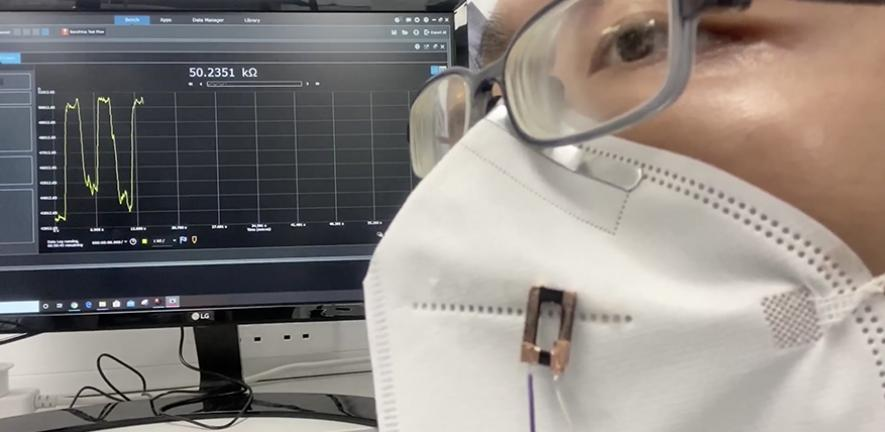Oct 1 2020
Right from capturing one’s breath to directing the movements of biological cells, 3D printing of small, transparent conducting fibers could be used for making devices that can “smell, hear and touch”—rendering it specifically handy for Internet of Things, health monitoring and biosensing applications.
 Fiber sensor attached to a face covering detects human breath with high sensitivity and responsiveness. Image Credit: Andy Wang.
Fiber sensor attached to a face covering detects human breath with high sensitivity and responsiveness. Image Credit: Andy Wang.
Scientists from the University of Cambridge utilized 3D printing, also called additive manufacturing, methods to create electronic fibers, each measuring 100 times thinner than a single strand of human hair, producing sensors that are beyond the abilities of traditional film-based devices.
Reported in the Science Advances journal, the fiber printing technique can be used for making portable, wearable, and non-contact respiratory sensors. Such printed sensors are economical, highly sensitive, and can be fixed to a mobile phone to obtain sound, images, and breath pattern data simultaneously.
Andy Wang, the study’s first author and a PhD student from the Department of Engineering at the University of Cambridge, used the fiber sensor to test the quantity of breath moisture that escapes via his face covering, for respiratory conditions like simulated coughing, rapid breathing, and normal breathing.
The fiber sensors considerably exceeded similar commercial sensors, particularly in tracking rapid breathing, which simulates the shortness of breath.
Although the fiber sensor has not been developed to spot viral particles, since scientific proof increasingly underscores the fact that viral particles like coronavirus can be transmitted via aerosols and respiratory droplets, quantifying the direction and amount of breath moisture that escapes via different kinds of face coverings could serve as an indicator in the protection “weak” points.
The researchers found that most leakage from surgical or fabric masks comes from the front, particularly at the time of coughing, while most leakage from N95 masks comes from the sides and top with tight fittings. Still, both kinds of face masks, when worn correctly, help to decrease the flow of exhaled breath.
Sensors made from small conducting fibres are especially useful for volumetric sensing of fluid and gas in 3D, compared to conventional thin-film techniques, but so far, it has been challenging to print and incorporate them into devices, and to manufacture them at scale.
Dr Yan Yan Shery Huang, Study Lead, Department of Engineering, University of Cambridge
Huang along with her collaborators 3D printed the composite fibers, which are produced from silver and/or semiconducting polymers. This kind of fiber printing method produces a core-shell fiber structure, with a high-purity conducting fiber core covered by a thin sheath of protective polymer, just like the structure of standard electrical wires, but at a scale of a few micrometers in diameter.
Besides the respiratory sensors, the printing method can also be used for making biocompatible fibers of an analogous dimension to biological cells, which allows them to guide the movements of cells and “feel” this dynamic process as electrical signals.
Moreover, the fibers are so small that they cannot be seen by the naked eye, and therefore, when they are used to join tiny electronic elements in 3D, it would look like the electronics are “floating” in mid-air.
Our fibre sensors are lightweight, cheap, small and easy to use, so they could potentially be turned into home-test devices to allow the general public to perform self-administered tests to get information about their environments.
Dr Yan Yan Shery Huang, Study Lead, Department of Engineering, University of Cambridge
The researchers are looking forward to develop this fiber printing method for several multi-functional sensors, which could possibly detect more breath species for bio-machine interface or for mobile health monitoring applications.
Journal Reference:
Wenyu Wang et al. (2020) Inflight fiber printing toward array and 3D optoelectronic and sensing architectures. Science Advances. https://doi.org/10.1126/sciadv.aba0931